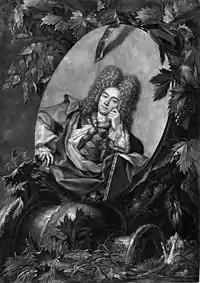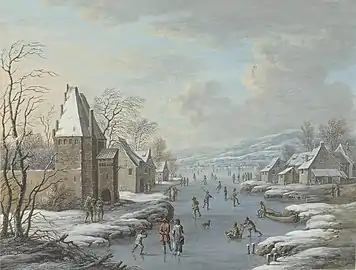Christoph Ludwig Agricola | |
|---|---|
 Portrait engraving by Bernhard Vogel | |
| Born | 5 November 1665 Regensburg, Germany |
| Died | 8 August 1724 (aged 58) Regensburg, Germany |
| Nationality | German |
| Education | Germany |
| Known for | Painting, etching |
Christoph Ludwig Agricola (5 November 1665 – 8 August 1724)[1] was a German landscape painter and etcher. He was born and died at Regensburg (Ratisbon).
Life and career
Christoph Ludwig Agricola was born on 5 November 1665 at Regensburg in Germany. He trained, as many painters of the period did, by studying nature.[2]
He spent a great part of his life in travel, visiting England, the Netherlands and France, and residing for a considerable period at Naples, where he may have been influenced by Nicolas Poussin.[3][4] He also stayed for some years circa 1712 in Venice, where he painted many works for the patron Zaccaria Sagredo.[5]
He died in Regensburg in 1724.
Work
Although he primarily worked in gouache and oils, documentary sources reveal that he also produced a small number of etchings.[6] He was a good draughtsman, used warm lighting and exhibited a warm, masterly brushstroke.[7]
His numerous landscapes, chiefly cabinet pictures, are remarkable for fidelity to nature, and especially for their skilful representation of varied phases of climate, especially nocturnal scenes and weather anomalies such as thunderstorms.[3][8] In composition his style shows the influence of Nicolas Poussin and his work often displays the idealistic scenes associated with Poussin.[9] In light and colour he imitates Claude Lorrain. His compositions include ruins of ancient buildings in the foreground, but his favourite figure for the foreground was men dressed in Oriental attire.[7] He also produced a series of etchings of birds.[10]
His pictures can be found in Dresden, Braunschweig, Vienna, Florence, Naples and many other towns of both Germany and Italy.
Legacy
He probably tutored the artist, Johann Theile, and had an enormous influence on him.[11] Art historians have also noted that the work of the landscape painter, Christian Johann Bendeler (1699–1728), was also influenced by Agricola.[8]
Gallery
_-_Eine_Flusslandschaft_mit_Anglern.jpg.webp) River landscape
River landscape Greater Redpole and crested titmous; Bluethroat
Greater Redpole and crested titmous; Bluethroat_-_R%C3%A4uber_schie%C3%9Fen_auf_Reisende.jpg.webp) Bandits Shooting at Travellers
Bandits Shooting at Travellers A bustard and a magpie in an exotic landscape
A bustard and a magpie in an exotic landscape A bird seated on a branch
A bird seated on a branch Winter face with ice entertainment
Winter face with ice entertainment Songbird in an Evergreen
Songbird in an Evergreen
References
- ↑ Braun-Ronsdorf, Margarete (1953), "Agricola, Christoph Ludwig", Neue Deutsche Biographie (in German), vol. 1, Berlin: Duncker & Humblot, p. 98; (full text online)
- ↑ Viardot, L., An Illustrated History of Painters of All Schools, Sampson, Low, Marston, Searle, & Rivington, 1877, p. 258; Kugler, F., Handbook of Painting: The German, Flemish, and Dutch Schools, Volume 2, J. Murray, 1874, p. 567
- 1 2 One or more of the preceding sentences incorporates text from a publication now in the public domain: Chisholm, Hugh, ed. (1911). "Agricola, Christoph Ludwig". Encyclopædia Britannica. Vol. 1 (11th ed.). Cambridge University Press. p. 386.
- ↑ Viardot, L., An Illustrated History of Painters of All Schools, Sampson, Low, Marston, Searle, & Rivington, 1877, p. 258; Kugler, F., Waagen, F.G. and Crowe, J.A., The German, Flemish and Dutch Schools of Painting, Volume 2, J. Murray, 1911, p. 567
- ↑ Boni, Page 8
- ↑ Ottley, W., Notices of Engravers, and Their Works, being the Commencement of a new Dictionary, which it is not intended to continue, containing some account of upwards of three hundred masters, etc, 1831
- 1 2 Kugler, F., Handbook of Painting: The German, Flemish, and Dutch Schools, Volume 2, J. Murray, 1874, p. 567
- 1 2 Koziel, A., "The Forgotten Star of Wroclaw: A Few Words about the Work of Christian Johann Bendeler (1699–1728)" in: Šeferisová Loudová, M., Kroupa, J. and Lubomír, K., Orbis artium: k jubileu Lubomíra Slavíčka, Vol. 1, Brno, Masarykova Univerzita, 2009, pp. 219–233 PDF Online:
- ↑ Macfall, H., The Renaissance in the North; and the Flemish Genius, [Volume 4 in the series, History of Painting], Dana Estes and Company, 2004, p.145
- ↑ Watercolours, Pictures and Prints of Birds [Auction Catalogue], Christie, Manson & Woods, 1989, pp 18–19
- ↑ Killy, W. and Vierhaus, R., Thibaut – Zycha, Walter de Gruyter, 2011, p. 2; Kugler, F., Waagen, F.G. and Crowe, J.A., The German, Flemish and Dutch Schools of Painting, Volume 2, J. Murray, 1911, p. 567
Further reading
- Boni, Filippo de' (1852). Biografia degli artisti ovvero dizionario della vita e delle opere dei pittori, degli scultori, degli intagliatori, dei tipografi e dei musici di ogni nazione che fiorirono da'tempi più remoti sino á nostri giorni. Seconda Edizione. Venice; Googlebooks: Presso Andrea Santini e Figlio. p. 8.